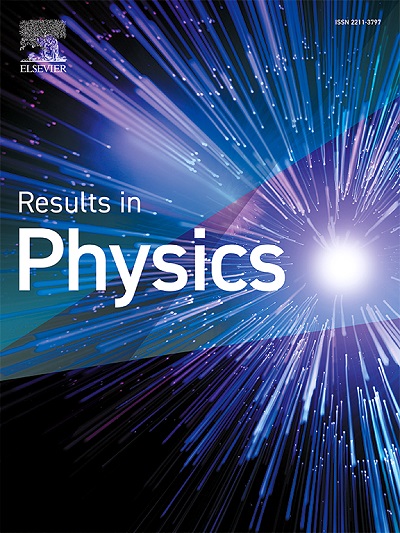Influence of Co2+ ions doping in Ni0.7-xCoxZn0.3Fe2O4 nanoferrites: A study of structural, morphological, optical, and magnetic properties
IF 4.4
2区 物理与天体物理
Q2 MATERIALS SCIENCE, MULTIDISCIPLINARY
引用次数: 0
Abstract
In the last few years, there has been a notable focus on the synthesis of soft magnetic nanoferrites with different properties for different applications. Highly efficient Cobalt (Co) assisted Ni0.7-xCoxZn0.3Fe2O4 (x = 0.0, 0.1, 0.2, 0.3, 0.4, and 0.5) nanoferrites were prepared via citrate gel combustion technique. XRD analysis revealed the single-phase cubic lattice growth, with a typical crystal size spanning between 33.81 and 42.45 nm. The unit cell volume and lattice parameter of Ni0.7-xCoxZn0.3Fe2O4 exhibited a significant increment with varying Co concentration (x = 0.1. 0.3, and 0.5), primarily because of expanded ionic radius of Co. Analysis with HRTEM revealed crystal sizes varying between 39.3 and 69.8 nm, confirming the nanocrystalline nature of the synthesized samples. Additionally, FESEM images indicated a spherical-like morphology for the nanoferrites. EDX analysis further validated the existence of all required elements such as Ni, Zn, Co, Fe, and O whitin the samples. SAED patterns and HRTEM images describe the pure and homogeneous crystalline cubic spinel lattice of nanoferrite including Moire fringes and d-spacing values consistent with XRD data and standard references. The FT-IR patterns exhibited absorption peaks within 533.1–545.6 cm−1 range, associated with metal–oxygen bond stretching vibration. The optical characteristics of the nanoferrites indicated activity in both the ultraviolet and visible ranges. The enhancement of visible light absorption in Ni0.7Zn0.3Fe2O4 nanoferrite through Co doping has been achieved. The band gap energy was noted to be reduced from 1.66 eV to 1.37 eV as the Co content increases from x = 0.0 to 0.5 in Ni0.7-xCoxZn0.3Fe2O4 nanoferrites. Magnetic characterization of the Co-doped samples reveals significant enhancements in magnetic behaviour. Saturation magnetization (Ms) improved from 69.93 to 80.36 emu/g with Co-doping, indicating an improved magnetic response. Similarly, the coercivity (Hc) and remanent magnetization (Mr) showed substantial increases, from 86.18 Oe to 160.97 Oe and from 13.65 emu/g to 25.61 emu/g, respectively. Among the samples, the nanoferrite with x = 0.4 exhibited the maximum value of Ms, while x = 0.5 demonstrated the highest values of Mr and Hc, suggesting the impact of Co concentration on optimizing magnetic properties across different compositions. Hence, x = 0.4 and 0.5 compositions of Ni0.7-xCoxZn0.3Fe2O4 nanoferrites would be strong candidates for electronic devices like sensors and memory strage.
Co2+离子掺杂对Ni0.7-xCoxZn0.3Fe2O4纳米铁氧体结构、形貌、光学和磁性的影响
近年来,合成具有不同性能的纳米软磁铁氧体已成为人们关注的焦点。采用柠檬酸凝胶燃烧技术制备了高效的钴(Co)辅助Ni0.7-xCoxZn0.3Fe2O4 (x = 0.0, 0.1, 0.2, 0.3, 0.4和0.5)纳米铁素体。XRD分析表明,该材料的晶粒尺寸为33.81 ~ 42.45 nm,呈单相立方晶格生长。随着Co浓度(x = 0.1)的变化,Ni0.7-xCoxZn0.3Fe2O4的晶胞体积和晶格参数显著增加。0.3和0.5),主要是由于Co的离子半径扩大。HRTEM分析显示晶体尺寸在39.3 ~ 69.8 nm之间,证实了合成样品的纳米晶体性质。此外,FESEM图像显示纳米铁素体呈球状形态。EDX分析进一步验证了样品中Ni、Zn、Co、Fe、O等所需元素的存在。SAED图和HRTEM图描述了纳米铁素体的纯净和均匀的立方尖晶石晶格,包括云纹条纹和与XRD数据和标准参考文献一致的d-间距值。FT-IR模式在533.1 ~ 545.6 cm−1范围内显示出吸收峰,与金属-氧键拉伸振动有关。纳米铁氧体的光学特性表明其在紫外和可见光范围内都具有活性。通过Co掺杂,实现了Ni0.7Zn0.3Fe2O4纳米铁氧体对可见光吸收的增强。当Co含量从x = 0.0增加到0.5时,Ni0.7-xCoxZn0.3Fe2O4纳米铁氧体的带隙能从1.66 eV降低到1.37 eV。共掺杂样品的磁性表征揭示了磁性行为的显著增强。饱和磁化强度(Ms)由69.93 emu/g提高到80.36 emu/g,表明磁响应得到改善。矫顽力(Hc)和剩余磁化强度(Mr)分别从86.18 Oe和13.65 emu/g显著增加到160.97 Oe和25.61 emu/g。样品中,当x = 0.4时,纳米铁氧体的Ms值最大,而x = 0.5时,Mr和Hc值最高,表明Co浓度对不同组成的磁性能优化有影响。因此,x = 0.4和0.5组成的Ni0.7-xCoxZn0.3Fe2O4纳米铁氧体将成为传感器和存储器等电子器件的有力候选材料。
本文章由计算机程序翻译,如有差异,请以英文原文为准。
求助全文
约1分钟内获得全文
求助全文
来源期刊

Results in Physics
MATERIALS SCIENCE, MULTIDISCIPLINARYPHYSIC-PHYSICS, MULTIDISCIPLINARY
CiteScore
8.70
自引率
9.40%
发文量
754
审稿时长
50 days
期刊介绍:
Results in Physics is an open access journal offering authors the opportunity to publish in all fundamental and interdisciplinary areas of physics, materials science, and applied physics. Papers of a theoretical, computational, and experimental nature are all welcome. Results in Physics accepts papers that are scientifically sound, technically correct and provide valuable new knowledge to the physics community. Topics such as three-dimensional flow and magnetohydrodynamics are not within the scope of Results in Physics.
Results in Physics welcomes three types of papers:
1. Full research papers
2. Microarticles: very short papers, no longer than two pages. They may consist of a single, but well-described piece of information, such as:
- Data and/or a plot plus a description
- Description of a new method or instrumentation
- Negative results
- Concept or design study
3. Letters to the Editor: Letters discussing a recent article published in Results in Physics are welcome. These are objective, constructive, or educational critiques of papers published in Results in Physics. Accepted letters will be sent to the author of the original paper for a response. Each letter and response is published together. Letters should be received within 8 weeks of the article''s publication. They should not exceed 750 words of text and 10 references.
 求助内容:
求助内容: 应助结果提醒方式:
应助结果提醒方式:


